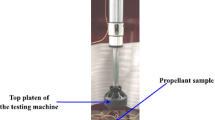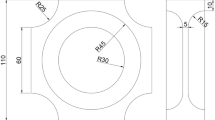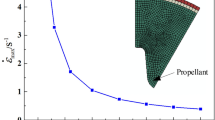Abstract
A thermo-damage-viscoelastic model for hydroxyl-terminated polybutadiene (HTPB) composite propellant with consideration for the effect of temperature was implemented in ABAQUS. The damage evolution law of the model has the same form as the crack growth equation for viscoelastic materials, and only a single damage variable \(S\) is considered. The HTPB propellant was considered as an isotropic material, and the deviatoric and volumetric strain-stress relations are decoupled and described by the bulk and shear relaxation moduli, respectively. The stress update equations were expressed by the principal stresses \(\sigma_{ii}^{R}\) and the rotation tensor \(M\), the Jacobian matrix in the global coordinate system \(J_{ijkl}\) was obtained according to the fourth-order tensor transformation rules. Two models having complex stress states were used to verify the accuracy of the constitutive model. The test results showed good agreement with the strain responses of characteristic points measured by a contactless optical deformation test system, which illustrates that the thermo-damage-viscoelastic model perform well at describing the mechanical properties of an HTPB propellant.












Similar content being viewed by others
References
Bernasconi, G., Piatti, G.: Creep of Engineering Materials and Structures, Ispra (Varese), Italy (1978), 6(9)
Cozzarelli, F.A., Bernasconi, G.: Non-linear creep damage under one-dimensional variable tensile stress. Int. J. Non-Linear Mech. 16(1), 27–38 (1981)
Deng, B., Xie, Y., Tang, G.J.: Three-dimensional structural analysis approach for aging composite solid propellant grains. Propellants Explos. Pyrotech. 39(1), 117–124 (2014)
Desmorat, R.: Damage and fatigue: continuum damage mechanics modeling for fatigue of materials and structures. Rev. Eur. de Génie Civ. 10(6–7), 849–877 (2006)
Gazonas, G.A.: A uniaxial nonlinear viscoelastic constitutive model with damage for M30 gun propellant. Mech. Mater. 15(4), 323–335 (1993)
Haj-Ali, R.M., Muliana, A.H.: Numerical finite element formulation of the Schapery non-linear viscoelastic material model. Int. J. Numer. Methods Eng. 59(1), 25–45 (2004)
Hinterhoelzl, R.M., Schapery, R.A.: FEM implementation of a three-dimensional viscoelastic constitutive model for particulate composites with damage growth. Mech. Time-Depend. Mater. 8(1), 65–94 (2004)
Kim, J., West, R.C.: Application of the viscoelastic continuum damage model to the indirect tension test at a single temperature. J. Eng. Mech. 136(4), 496–505 (2010)
Kim, Y.R., Baek, C., Underwood, B.S., Subramanian, V., Guddati, M.N., Lee, K.: Application of viscoelastic continuum damage model based finite element analysis to predict the fatigue performance of asphalt pavements. J. Civ. Eng. 12(2), 109–120 (2008)
Lundstrom, R., Ekblad, J.: Fatigue characterization of asphalt concrete using Schapery’s work potential model. Annu. Trans. Nord. Rheol. Soc. 14, 227–234 (2006)
Mun, S.: Numerical computation in the viscoelastoplastic continuum damage of hot mix asphalt concrete. Fatigue Fract. Eng. Mater. Struct. 32(12), 995–1003 (2009)
Mun, S., Guddati, M.N., Kim, Y.R.: Continuum damage finite element modeling of asphalt concrete. J. Civ. Eng. 9(3), 205–211 (2005)
Park, S.W., Schapery, R.A.: A viscoelastic constitutive model for particulate composites with growing damage. Int. J. Solids Struct. 34(8), 931–947 (1997)
Park, S.W., Richard Kim, Y., Schapery, R.A.: A viscoelastic continuum damage model and its application to uniaxial behavior of asphalt concrete. Mech. Mater. 24(4), 241–255 (1996)
Rouleau, L., Deü, J.F., Legay, A., et al.: Application of Kramers–Kronig relations to time–temperature superposition for viscoelastic materials. Mech. Mater. 65(10), 66–75 (2013)
Schapery, R.A.: A theory of crack initiation and growth in viscoelastic media, Part I: Theoretical development, Part II: approximate methods of analysis, Part III: analysis of continuous growth. Int. J. Fract. 11, 141–159 (1975). 369–388, 549–562
Schapery, R.A.: Correspondence principles and a generalized \(J\) integral for large deformation and fracture analysis of viscoelastic media. Int. J. Fract. 25(3), 195–223 (1984)
Schapery, R.A.: A theory of mechanical behavior of elastic media with growing damage and other changes in structure. J. Mech. Phys. Solids 38(2), 215–253 (1990)
Schapery, R.A.: Nonlinear viscoelastic and viscoplastic constitutive equations with growing damage. Int. J. Fract. 97(1–4), 33–66 (1999)
Stigh, U.: Continuum damage mechanics and the life-fraction rule. J. Appl. Mech. 73(4), 702–704 (2006)
Sun, C., Xu, J., Chen, X., et al.: Strain rate and temperature dependence of the compressive behavior of a composite modified double-base propellant. Mech. Mater. 89, 35–46 (2015)
Underwood, B.S., Kim, Y.R., Guddati, M.N.: Characterization and performance prediction of ALF mixtures using a viscoelastoplastic continuum damage model. Asph. Paving Technol. 75, 577–636 (2006)
Xu, J., Chen, X., Wang, H., et al.: Thermo-damage-viscoelastic constitutive model of HTPB composite propellant. Int. J. Solids Struct. 51(18), 3209–3217 (2014)
Zalewski, R., Wolszakiewicz, T.: Analysis of uniaxial tensile tests for homogeneous solid propellants under various loading conditions. Central Eur. J. Energ. Mater. 8(4), 223–231 (2011)
Acknowledgements
This work was supported by National Natural Science Foundation of China, NFSC (51606098), Natural Science Foundation of Jiangsu Province (No. BK20140772), the Fundamental Research Funds for the Central Universities (No. 30915011301; No. 30915118805). We thank LetPub (www.letpub.com) for its linguistic assistance during the preparation of this manuscript.
Author information
Authors and Affiliations
Corresponding author
Rights and permissions
About this article
Cite this article
Xu, J., Han, L., Zheng, J. et al. Finite element implementation of a thermo-damage-viscoelastic constitutive model for hydroxyl-terminated polybutadiene composite propellant. Mech Time-Depend Mater 21, 577–595 (2017). https://doi.org/10.1007/s11043-017-9343-2
Received:
Accepted:
Published:
Issue Date:
DOI: https://doi.org/10.1007/s11043-017-9343-2




